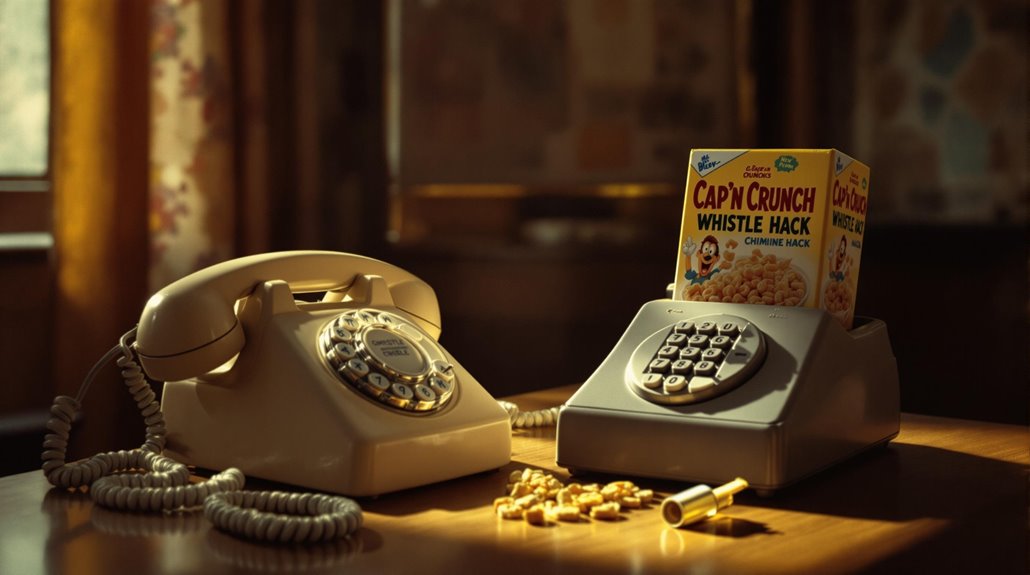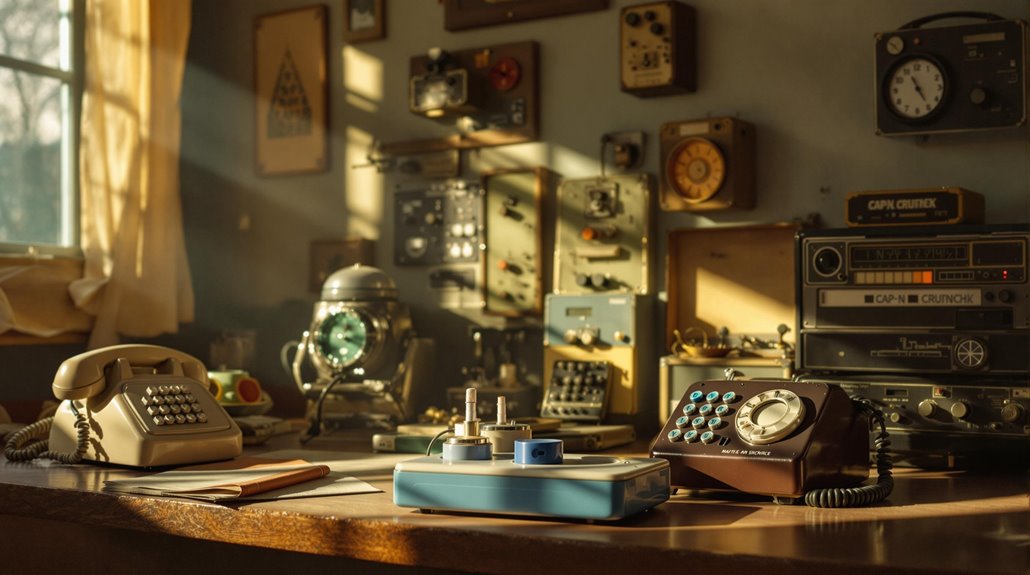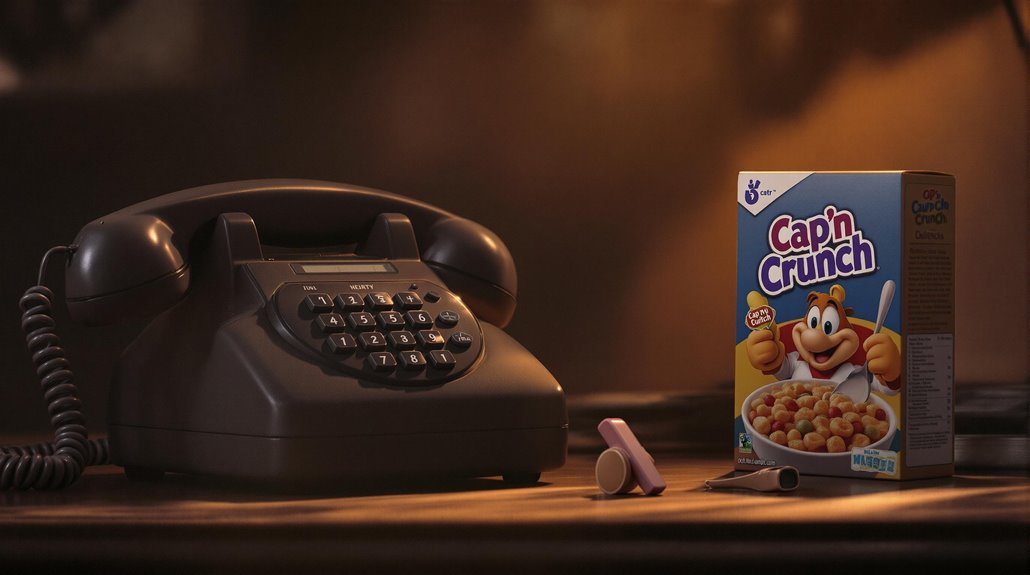Cap’n Crunch’s Whistle Hack: The Start of Phone Phreaking
You've probably heard stories about hackers breaking into complex computer systems, but one of the most influential hacks began with a simple toy whistle from a cereal box. In the late 1960s, this plastic whistle would expose a vulnerability in AT&T's entire phone network, launching a movement that shaped modern tech culture. The tale of Cap'n Crunch's whistle connects a peculiar cast of characters, from an eccentric former Air Force technician to two young entrepreneurs named Steve.
The Accidental Discovery That Changed Telecommunications

While Cap'n Crunch cereal aimed to delight kids with a simple toy whistle in the late 1960s, no one could've predicted that this plastic prize would expose a major vulnerability in America's telephone system.
What started as cereal nostalgia turned into an accidental discovery when someone noticed the whistle produced a perfect 2600 Hz tone – exactly matching AT&T's frequency for line control. Much like Karl Jansky's discovery of cosmic radio waves, this finding was completely unintentional.
This simple toy could trick the phone network's in-band signaling system, disconnecting one end of a trunk line and leaving the other in operator mode. John Draper went on to create blue box devices that could replicate these tones more reliably.
You'd never guess that a breakfast cereal premium would spark a digital revolution, inspiring early phone phreakers, future tech pioneers like Steve Wozniak and Steve Jobs, and ultimately forcing telecom companies to strengthen their network security.
John Draper: From Air Force Tech to Phone Network Legend
Before becoming known as "Captain Crunch," John Draper's journey into phone phreaking began with his service as a U.S. Air Force electronics technician.
Working with long-range radar and radio encryption equipment, he developed essential skills that would shape his future innovations in telecommunications.
After leaving the military, Draper worked as an engineering technician at National Semiconductor, where his expertise in electronic design continued to grow.
His path took an unexpected turn when he met blind phone phreak Denny Teresi, leading him to build the infamous blue box tone generator.
He gained his famous nickname after discovering that a toy whistle found in Cap'n Crunch cereal boxes could produce 2600 Hz tones perfectly.
The underground community of phreakers quickly embraced his discoveries, forming tight-knit groups dedicated to exploring telecommunication systems.
Draper's legacy extends far beyond his phone phreaking days.
His Air Force innovations and technical knowledge later helped him create EasyWriter, a groundbreaking word processor, and develop significant security tools at companies like Autodesk and ShopIP.
He's now recognized as a pioneering figure who influenced tech legends like Jobs and Wozniak.
How a Simple Cereal Box Toy Exposed Network Vulnerabilities
The story of phone phreaking's most famous hack began with a simple plastic toy whistle found in boxes of Cap'n Crunch cereal.
This seemingly innocent toy, designed to mimic boatswain whistles, had an unexpected feature: when you blocked its inner hole, it produced a perfect 2600 Hz tone that matched AT&T's trunk line signaling frequency.
Former Air Force radar technician John Draper would go on to leverage his technical expertise to fully understand and exploit these network vulnerabilities.
The whistle impact was immediate and far-reaching.
By blowing the whistle into a phone receiver, you could trick AT&T's network into entering operator mode, enabling free long-distance calls and system manipulation.
Using specialized equipment like two blue boxes, engineers confirmed the whistle's ability to generate the precise frequency needed.
This cereal innovation unintentionally exposed critical vulnerabilities in the telephone network's in-band signaling system.
The discovery sparked a wave of technological exploration, leading to sophisticated hacking tools like "blue boxes" and eventually forcing the telecom industry to develop more secure signaling systems.
The Technical Magic Behind the 2600 Hz Tone
At the heart of phone phreaking's most famous exploit lay a precise 2600 Hz tone that released AT&T's vast telephone network. This frequency served as a control signal, indicating when long-distance trunk lines were idle and available for use.
The network's tone generation system relied on sophisticated bandpass filters to detect the 2600 Hz frequency. You couldn't just whistle any tone – the system would only respond when 2600 Hz was the dominant signal, carefully filtering out similar frequencies from speech or music. Continuous tone methods made detecting idle trunk lines remarkably straightforward. The most effective tone generation came from sine-wave output for superior sound quality.
This signal manipulation made the hack particularly clever, as the Cap'n Crunch whistle produced the exact frequency needed to trick the system.
As phreaking evolved, blue boxes emerged to generate both the 2600 Hz tone and additional control frequencies, enabling users to exploit the network's inner workings for free calls.
Silicon Valley's Secret Connection to Phone Phreaking
While phone phreaking captivated tech enthusiasts nationwide, its most profound impact emerged in Silicon Valley through two young entrepreneurs – Steve Jobs and Steve Wozniak.
After learning about phreaking from a 1971 Esquire article, Wozniak designed advanced blue boxes that he and Jobs would sell before founding Apple Computer. The blue boxes marked a significant milestone, as they were sophisticated tools inspired by John Draper's original designs.
This early tech exploration wasn't just about making money – it helped shape Silicon Valley's innovative culture. By challenging AT&T's closed system, these pioneers developed essential problem-solving skills and embraced a hacker ethos that would define the region's approach to technology.
 upgrading to digital switches in 1976, marking a new era in telecommunications.
upgrading to digital switches in 1976, marking a new era in telecommunications.










